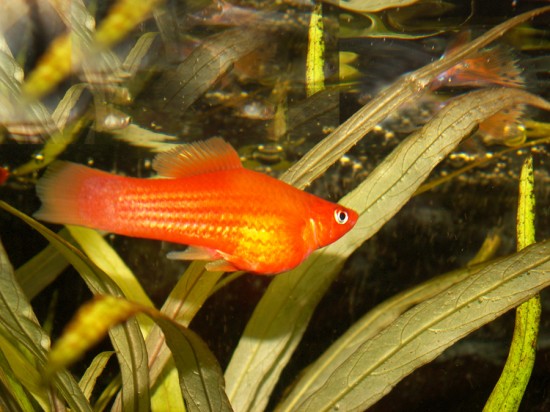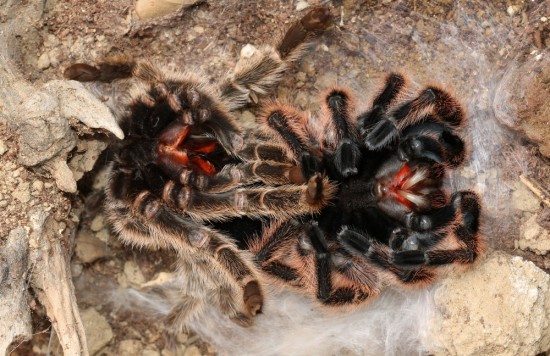

Your fish tank is a micro world, where your fish's lives play out before your eyes. You get to watch them play, fight, feed and live out their lives, and it's only natural that you would want to take this to the next level and breed your fish. Watch the life cycle begin a fresh, raise the fry to full adults, and maybe sell the grown fish on.
Breeding fish can be incredibly rewarding, getting a good pair of fish, watching them set up a territory, lay eggs, guard and take care of them, watching the eggs hatch into wrigglers and waiting until that day that they are free swimming. Maybe following their parents around, or waiting till you come into feed them. Watching them grow every single day, going from a generic fry shape, growing gradually into miniature adults, getting the correct shapes, colours, and maybe, just maybe, finding one that is a new colour, is a better shape, maybe you want to show your fish at a competition, or just enjoy them at home.
But it can be a different story some times. The adults may pair off, and despite a tank to themselves, quality food, and water as perfect as you can, they just don't breed, or they do, and the eggs aren't fertile. Sometimes they do breed, and then one day the fry are just gone. The parents for some unknown reason have decided to snack on the young. Or maybe you have removed them from the parents, and they just die, one by one, or all at once. Or they grow, and suddenly you realise that some aren't the right colour, they aren't the right shape, some have problems that mean it would be cruel to let them live, or just that you'll never be able to sell them. Culling out these imperfect fish can be horrible, but what are you to do with them. 1000s of koi fry are culled before that one quality fish is chosen, unless you have an unlimited supply of tanks at one point or another you'll have to dispatch some of those deformed fry. Finally you've got some through to be large enough to take to the fish store, and they give you 20p per fish, or even less, or maybe just take them in and offer you nothing.
So how do you start on this rollercoaster that is breeding fish.
Fish can and will breed in a general tank, but the eggs and the young can and will get eaten. Some parents guard the babies and may hurt and kill other fish in defence of the young, but normally the other fish get in anyway. For breeding you'll need at the very least a separate tank for the parents, if they can go back in the main tank afterwards then you can raise the young in that tank, but otherwise you'll need to have a second tank to raise the young in. Each of these will need a filter and a heater. I tend to use air driven sponge filters in the tanks, there is less chance of the young being pulled into the filter, and the sponge filter often has life on it that may provide food for the new fry.
So you have your tanks set up, cycled from the main tank so the bacteria levels are steady. Now where?
Well your first thought has to be what sort of fish you want to breed, guppies and other livebearers will breed at will in the tank, but for watching the parents care for the eggs and raise the fry nothing beats cichlids.
The British Cichlid Association are fond of saying that there is a cichlid for every tank, and if you're looking for advice they are a good place to start. But the saying is true, from the small south American cichlids, to the larger central American cichlids, or the colourful rift lake cichlids, there is a huge variety out there.
Kribs Pelvis Pulcher are a great beginners' fish. Males are larger and have more pointed tails, whilst the smaller females are rounder and when breeding have the most amazing purple bellies. You can buy good quality fish from your local fish store, and the assistant should be able to give you a pair easily. Unlike some other cichlids, kribs tend to be happy with each other as long as there is a male and a female.
Another fish, although not a cichlid, I enjoy raising are Corydoras catfish, these little guys lay eggs which you have to remove before the parents see them as a snack. For this you tend to need a female and two males at least. Females tend to be plumper than the males. I tend to buy a group of youngsters and let them grow up together, if you have at least five there is a good chance you'll get a good mix.
So you've got the prospective parents, now comes the hard work. You need to get them so that they think it's time to breed. They need to be big and old enough, this might mean waiting a few months, until they are adults.
I feed the parents a quality food whilst I'm trying to get them into condition. I raise live food for them, including brine shrimp, species of live worm suitable for feeding to fish, and daphnia, these can also be fed to the fry once they have arrived, different foods as the fry grow. They also get suitable flake or pellet food, and if their diet requires vegetable, or protein. Water changes are just as important, you want the fish to think that it is the spring and all that fresh melt water is coming down the rivers, signalling that soon there will be food for the young fish often in the form of insect larva and invertebrates that are also being born in the spring. For cories you need to do a huge water change, and provide some form of flow to mimic these spring flood conditions, and normally this works.
Kribs tend to set up territory in a cave, I use half a new terracotta plant pot, this seems to be their favourite home, you'll get to watch the two display to each other, and their colours get more and more vibrant, the females belly becoming a deep purple, the males fin getting highlighted in blue, shivering and dancing around each other, and then one day one or both hiding in the cave, guarding the precious eggs.
The cories spawn normally on the side of the tank, I tend to angle the flow so it's on the front of the tank, just to make my life easier, some people then remove the parents to another tank, however I use a plastic scraper to remove the sticky eggs from the tank, and transfer them straight into a clean ice-cream container of water.
Now you have eggs, I place the containers on top of another tank to keep the water warm, drop an air stone into the water and keep an eye on the eggs, sadly often you lose them to fungus, the eggs turning into little balls of fur. Often people use medication to keep this at bay, I've personally had success by putting the eggs into clean water that has never been in a tank, just make sure it's the correct temperature.
Kribs make great parents, sheparding the young around the tank, it's not unheard of for new parents to eat their eggs or fry, but just give them another chance, you can remove the young, but I love watching the parents chasing after errant fry, grabbing them in their mouths and bringing them back to spit out where ever they think the young should be.
Feeding the small mouths can be a problem, Baby brine shrimp are a firm favourite with fish keepers, easy to raise, and relatively inexpensive, I also have Banana, Micro and Walter worms to feed the fry, and often have a culture of daphnia going. You can also buy powdered fry food, but the live food seems to bring better results.
You should by now be enjoying watching the fry whiz round the tank. Often fish breeders keep the bottom of the tank bare and ornaments to a minimum so as cleaning is easier. Keep the tank as clean as possible and the fry will grow quicker and be healthier for it.
But most of all enjoy them, it can be a magically frustrating and enchantingly addictive to watch the young lives form.
 Tarantulas And Moulting
Tarantulas And Mo
Tarantulas And Moulting
Tarantulas And Mo
 Conjunctivitis In Cats - Feline Conjunctivitis
Conjunctivitis In
Conjunctivitis In Cats - Feline Conjunctivitis
Conjunctivitis In
 Now Get Dog Food, Toys and Pet Supplies in Flinders View and Ipswich with Greatest Ease
Now Get Dog Food, Toys and Pet Supplies in Flinders View a
Now Get Dog Food, Toys and Pet Supplies in Flinders View and Ipswich with Greatest Ease
Now Get Dog Food, Toys and Pet Supplies in Flinders View a
 Dogs And Territorial Behaviour
Dogs And Territor
Dogs And Territorial Behaviour
Dogs And Territor
 Tips For Finding A Lost Pet
Tips For Finding
Tips For Finding A Lost Pet
Tips For Finding
Copyright © 2005-2016 Pet Information All Rights Reserved
Contact us: www162date@outlook.com